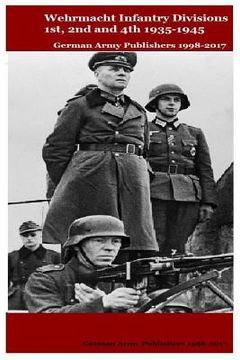Reseña del libro "Wehrmacht Infantry Divisions 1st, 2nd and 4th 1935-1945 (en Inglés)"
Following the invasion of Poland in September 1939 (which started the Second World War), a period of inaction called the Phony War ("Sitzkrieg" or "Drôle de guerre") set in between the major powers. Adolf Hitler had hoped that France and Britain would acquiesce in his conquest and quickly make peace. On 6 October, he made a peace offer to both Western Powers. Even before they had time to respond, on 9 October, he also formulated a new military policy in case their reply was negative: Führer-Anweisung N 6, or "Führer-Directive Number 6". Hitler had always fostered dreams about major military campaigns to defeat the Western European nations as a preliminary step to the conquest of territory in Eastern Europe, thus avoiding a two-front war. However, these intentions were absent from Führer-Directive N 6. This plan was firmly based on the seemingly more realistic assumption that Germany's military strength would still have to be built up for several more years and that for the moment only limited objectives could be envisaged. They were aimed at improving Germany's ability to survive a long, protracted war in the West. Hitler ordered a conquest of the Low Countries to be executed at the shortest possible notice. This would stop France from occupying them first, and prevent Allied air power from threatening the vital German Ruhr Area. It would also provide the basis for a successful long-term air and sea campaign against Britain. There was no mention in the Führer-Directive of any immediate consecutive attack to conquer the whole of France, although as much as possible of the border areas in northern France should be occupied. While writing the directive, Hitler had also assumed that such an attack could be initiated within a period of at most a few weeks, but the very day he issued it he was disabused of this illusion. It transpired that he had been misinformed about the true state of Germany's forces. The motorized units had to recover, repairing the damage to their vehicles incurred in the Polish campaign, and ammunition stocks were largely depleted On 10 October 1939, the British refused Hitler's offer of peace; on 12 October, the French did the same. Franz Halder, the chief of staff of the German Army (Generalstabschef des Heeres), presented the first plan for Fall Gelb ("Case Yellow") on 19 October, the pre-war codename of plans for campaigns in the Low Countries: the Aufmarschanweisung N 1, Fall Gelb ("Deployment Instruction No. 1, Case Yellow"). Halder's plan has often been compared to the Schlieffen Plan, which the Germans attempted to execute in 1914 during the opening phase of the First World War. It was similar in that both plans entailed an advance through the middle of Belgium, but while the intention of the Schlieffen Plan was to gain a decisive victory by executing a surprise encirclement of the French Army, Aufmarschanweisung N 1 was based on an unimaginative frontal attack, sacrificing a projected half a million German soldiers to attain the limited goal of throwing the Allies back to the River Somme. Germany's strength for 1940 would then be spent; only in 1942 could the main attack against France begin.

